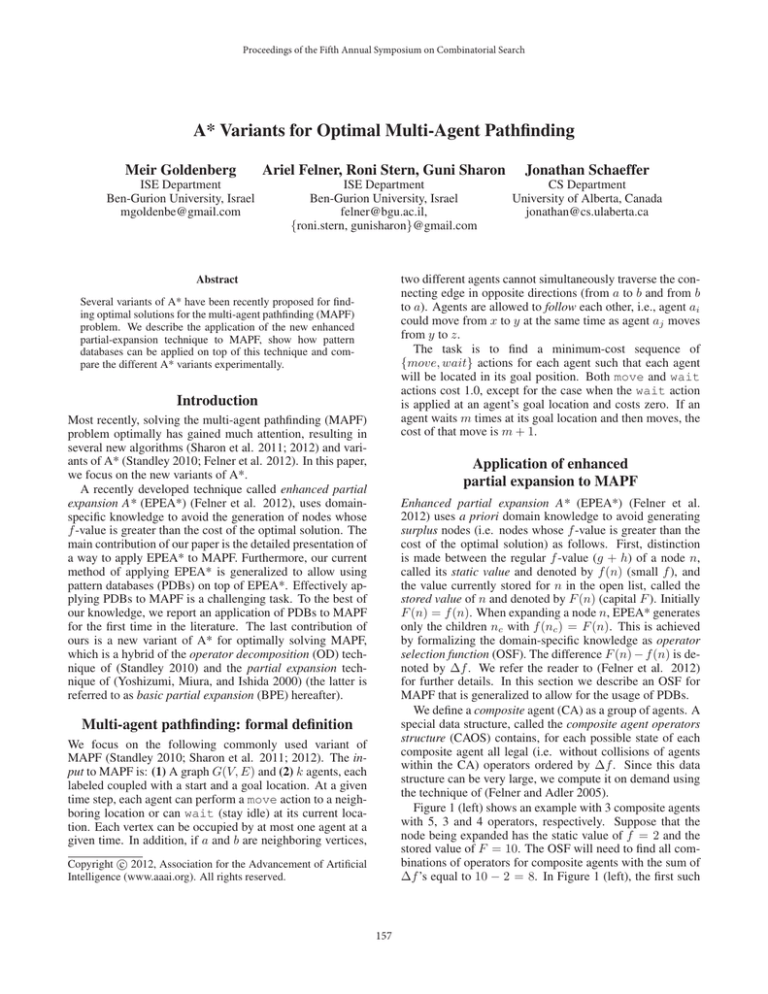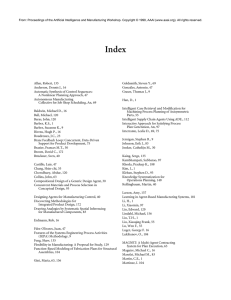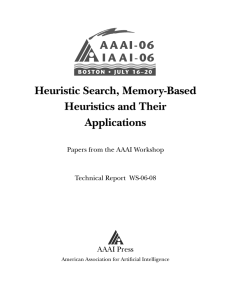
Proceedings of the Fifth Annual Symposium on Combinatorial Search
A* Variants for Optimal Multi-Agent Pathfinding
Meir Goldenberg
Ariel Felner, Roni Stern, Guni Sharon
Jonathan Schaeffer
ISE Department
Ben-Gurion University, Israel
mgoldenbe@gmail.com
ISE Department
Ben-Gurion University, Israel
felner@bgu.ac.il,
{roni.stern, gunisharon}@gmail.com
CS Department
University of Alberta, Canada
jonathan@cs.ulaberta.ca
two different agents cannot simultaneously traverse the connecting edge in opposite directions (from a to b and from b
to a). Agents are allowed to follow each other, i.e., agent ai
could move from x to y at the same time as agent aj moves
from y to z.
The task is to find a minimum-cost sequence of
{move, wait} actions for each agent such that each agent
will be located in its goal position. Both move and wait
actions cost 1.0, except for the case when the wait action
is applied at an agent’s goal location and costs zero. If an
agent waits m times at its goal location and then moves, the
cost of that move is m + 1.
Abstract
Several variants of A* have been recently proposed for finding optimal solutions for the multi-agent pathfinding (MAPF)
problem. We describe the application of the new enhanced
partial-expansion technique to MAPF, show how pattern
databases can be applied on top of this technique and compare the different A* variants experimentally.
Introduction
Most recently, solving the multi-agent pathfinding (MAPF)
problem optimally has gained much attention, resulting in
several new algorithms (Sharon et al. 2011; 2012) and variants of A* (Standley 2010; Felner et al. 2012). In this paper,
we focus on the new variants of A*.
A recently developed technique called enhanced partial
expansion A* (EPEA*) (Felner et al. 2012), uses domainspecific knowledge to avoid the generation of nodes whose
f -value is greater than the cost of the optimal solution. The
main contribution of our paper is the detailed presentation of
a way to apply EPEA* to MAPF. Furthermore, our current
method of applying EPEA* is generalized to allow using
pattern databases (PDBs) on top of EPEA*. Effectively applying PDBs to MAPF is a challenging task. To the best of
our knowledge, we report an application of PDBs to MAPF
for the first time in the literature. The last contribution of
ours is a new variant of A* for optimally solving MAPF,
which is a hybrid of the operator decomposition (OD) technique of (Standley 2010) and the partial expansion technique of (Yoshizumi, Miura, and Ishida 2000) (the latter is
referred to as basic partial expansion (BPE) hereafter).
Application of enhanced
partial expansion to MAPF
Enhanced partial expansion A* (EPEA*) (Felner et al.
2012) uses a priori domain knowledge to avoid generating
surplus nodes (i.e. nodes whose f -value is greater than the
cost of the optimal solution) as follows. First, distinction
is made between the regular f -value (g + h) of a node n,
called its static value and denoted by f (n) (small f ), and
the value currently stored for n in the open list, called the
stored value of n and denoted by F (n) (capital F ). Initially
F (n) = f (n). When expanding a node n, EPEA* generates
only the children nc with f (nc ) = F (n). This is achieved
by formalizing the domain-specific knowledge as operator
selection function (OSF). The difference F (n) − f (n) is denoted by ∆f . We refer the reader to (Felner et al. 2012)
for further details. In this section we describe an OSF for
MAPF that is generalized to allow for the usage of PDBs.
We define a composite agent (CA) as a group of agents. A
special data structure, called the composite agent operators
structure (CAOS) contains, for each possible state of each
composite agent all legal (i.e. without collisions of agents
within the CA) operators ordered by ∆f . Since this data
structure can be very large, we compute it on demand using
the technique of (Felner and Adler 2005).
Figure 1 (left) shows an example with 3 composite agents
with 5, 3 and 4 operators, respectively. Suppose that the
node being expanded has the static value of f = 2 and the
stored value of F = 10. The OSF will need to find all combinations of operators for composite agents with the sum of
∆f ’s equal to 10 − 2 = 8. In Figure 1 (left), the first such
Multi-agent pathfinding: formal definition
We focus on the following commonly used variant of
MAPF (Standley 2010; Sharon et al. 2011; 2012). The input to MAPF is: (1) A graph G(V, E) and (2) k agents, each
labeled coupled with a start and a goal location. At a given
time step, each agent can perform a move action to a neighboring location or can wait (stay idle) at its current location. Each vertex can be occupied by at most one agent at a
given time. In addition, if a and b are neighboring vertices,
c 2012, Association for the Advancement of Artificial
Copyright Intelligence (www.aaai.org). All rights reserved.
157
CA1 CA2 CA3
0
0
0
0
1
1
3
3
4
3
4
5
k Ins
2-6 1
7-8 25
9-10 13
Unique Nodes Generated, ×103
Run-Time, ms
ODA* BPEODA* EPEA* EPEA*+PDBs ODA* BPEODA* EPEA* EPEA*+PDBs
335.34
105.14
9.94
9.31 2,153
1,803
278
354
219.11
67.04
7.82
4.41 1,637
1,312
335
232
705.76
211.54 17.57
10.01 16,660
8,846 3,062
1,089
Figure 1: Left: Computing OSF for MAPF
choice is shown in solid.
Effectively, we have to solve the following combinatorial
enumeration problem: given k bins with balls each tagged
with a number, enumerate all ways of choosing one ball
from each bin, such that the total sum of the numbers on the
balls is ∆f . Since this problem is exponential in the number of bins (which corresponds to the number of composite
agents) and is solved for every expansion, it is critical that
this problem be solved efficiently.
Our solution is a simple recursive procedure with several
enhancements (which we hope to described in a full version of the paper). For the above example with three bins,
this procedure tries each of the choices for the first bin and
performs a recursive call with the update sum for the remaining bins. For example, when the third choice (which
is the first operator with individual ∆f = 3) is tried for
the first (i.e. left-most) bin, the remaining two bins have to
contribute 8 − 3 = 5 to the sum. Therefore, we can use a
recursive call to our procedure for the remaining two bins
and the required sum of 5.
Right: comparison of A* variants
various numbers of agents. Except for the most trivial instances A* and BPEA* were not able to solve the problem
within the allocated resources (two minutes and two gigabytes of memory per instance). First, as reported by (Standley 2010), ODA* is faster than A*. Second, BPEA* is
faster than A*, but it suffers from the overhead of generating the surplus nodes in order to prune them away. Third,
BPEODA* significantly outperforms both A* and ODA*
due to maintaining a much smaller open list resulting in
cheaper open list operations. EPEA* is faster than all these
variants. In addition, for hard instances, PDBs give a significant (up to three times on average) improvement on top
of EPEA*. Since the PDBs are instance-dependent, their
building times cannot be amortized over all instances. However, we see that building PDBs well pays off for the hard
instances. For easier instances, EPEA*+PDBs was still the
best algorithm in terms of nodes, but not in terms of time.
Conclusions
We presented a study of several variants of A* for optimally
solving the multi-agent pathfinding (MAPF) problem. We
hope to present several important and hitherto uncovered insights about the techniques of (Standley 2010) in the full
version of the paper.
PDBs for MAPF
PDBs for MAPF can be effective only if they are built for
agents that participate in many conflicts. However, this information is not known a priori. For example, given an instance with 20 agents, a special method is needed to find an
effective way to pair up the agents for pairwise databases.
We overcome this problem by using the independence detection (ID) framework of (Standley 2010). Whenever ID
joins two agents into a group, we use this information to
build pairwise PDBs at later stages of ID.
Acknowledgements
This research was supported by the Israeli Science Foundation (ISF) grant 305/09 to Ariel Felner and the Natural Sciences and Engineering Research Council of Canada grant to
Jonathan Schaeffer.
References
Basic partial expansion (BPE) A* with
operator decomposition
Felner, A., and Adler, A. 2005. Solving the 24-puzzle with
instance dependent pattern databases. In SARA-05, 248–260.
Felner, A.; Goldenberg, M.; Sharon, G.; Stutervant, N.;
Stern, R.; Beja, T.; Schaeffer, J.; and Holte, R. 2012. Partialexpansion a* with selective node generation. In to appear in
AAAI.
Sharon, G.; Stern, R.; Goldenberg, M.; and Felner, A.
2011. The increasing cost tree search for optimal multiagent pathfinding. In IJCAI, 662–667.
Sharon, G.; Stern, R.; Felner, A.; and Sturtevant, N. R. 2012.
Conflict-based search for optimal multi-agent path finding.
In to appear in AAAI.
Standley, T. 2010. Finding optimal solutions to cooperative
pathfinding problems. In AAAI, 173–178.
Yoshizumi, T.; Miura, T.; and Ishida, T. 2000. A* with
partial expansion for large branching factor problems. In
AAAI/IAAI, 923–929.
BPEA* (our term for the technique of (Yoshizumi, Miura,
and Ishida 2000)) is generic and can be applied on top of any
procedure for neighbor generation. In particular, BPEA*
can be applied on top of operator decomposition due to
(Standley 2010) as follows. Each intermediate note is a successor of some standard node. The most immediate such
standard node is called the standard predecessor of the intermediate node. When a node n is expanded there are two
cases: (1) if n is standard, then the regular BPE condition
applies, otherwise (2) a child nc is kept only if it’s f -value
is equal to the stored value of the standard predecessor of the
node being expanded. We call this algorithm BPEODA*.
Experimental results
Figure 1 (right) shows the comparison of different algorithms on a four-connected 8x8 grid with no obstacles with
158





